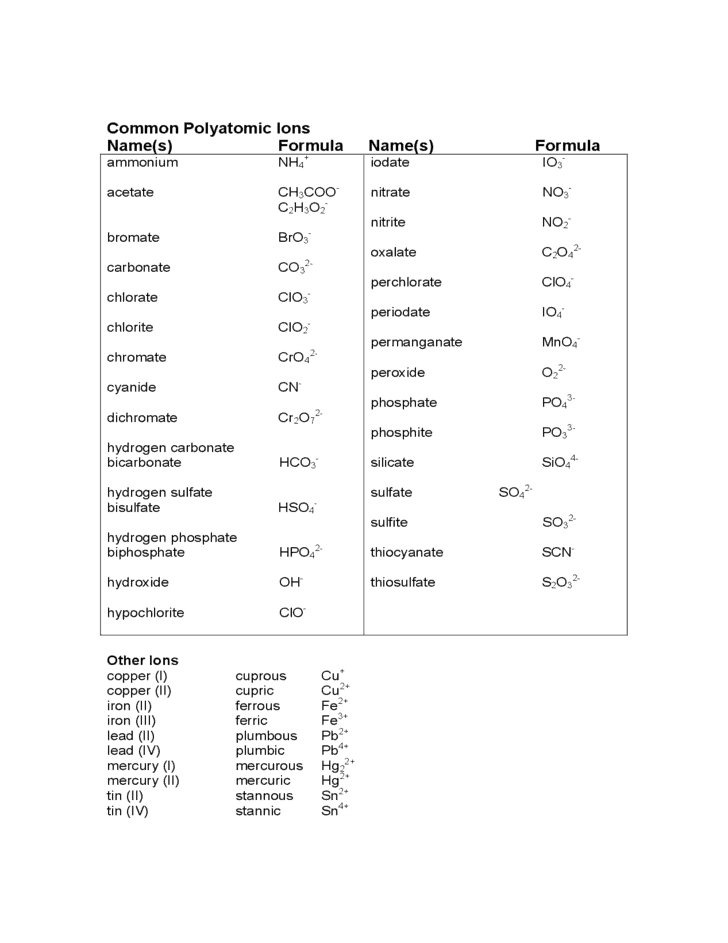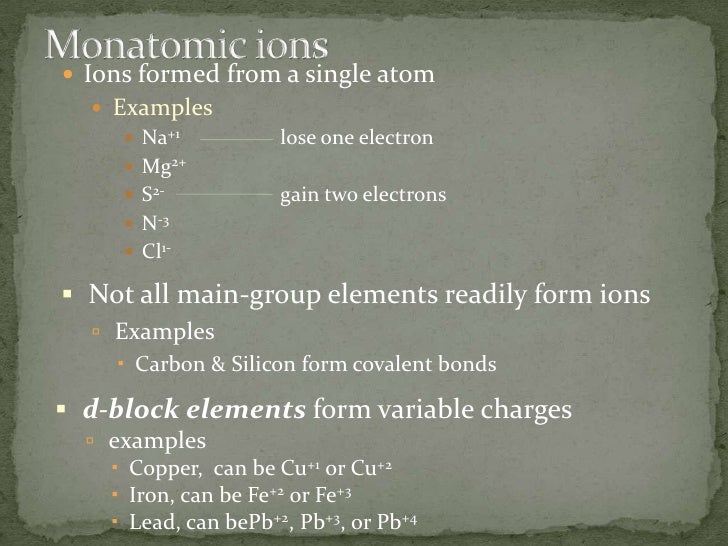- Polyatomic Atoms Def
- Polyatomic Atoms
- Polyatomic Ion Formula
- Polyatomic Atoms Explained
- Which Ion Is A Polyatomic Ion
Polyatomic ions are charged groups of atoms. An example is ammonium ion, NH 4 +.It has five atoms (one nitrogen and four hydrogens) that share a charge of +1. The polyatomic ions remain intact, and parentheses may be required when using subscripts.
Learning Objective


- Convert between the structure of an acid or base and its chemical name
Polyatomic Atoms Def
Key Points
A polyatomic ion is an ion composed of more than one atom. The ammonium ion consists of one nitrogen atom and four hydrogen atoms. Together, they comprise a single ion with a 1 + charge and a formula of NH 4 +. The carbonate ion consists of one carbon atom and three oxygen atoms, and carries an overall charge of 2 −. Polyatomic ionA charged species (ion) composed of two or more atoms covalently bonded. Also known as a molecular ion.
- Acids are named based on their anion — the ion attached to the hydrogen. In simple binary acids, one ion is attached to hydrogen. Names for such acids consist of the prefix “hydro-“, the first syllable of the anion, and the suffix “-ic”.
- Complex acid compounds have oxygen in them. For an acid with a polyatomic ion, the suffix “-ate” from the ion is replaced with “-ic.”
- Polyatomic ions with one extra oxygen (as compared to the typical polyatomic ion) have the prefix “per-” and the suffix “-ic.”
- Polyatomic ions with one fewer oxygen have the suffix “-ous”; ions with two fewer have the prefix “hypo-” and the suffix “-ous.”
- Strong bases with “-OH” (hydroxide) groups are named like ionic compounds. Weak bases are named like molecular compounds or organic compounds.
Term
- polyatomic ionA charged species (ion) composed of two or more atoms covalently bonded. Also known as a molecular ion.
Naming Acids
Acids are named by the anion they form when dissolved in water. Depending on what anion the hydrogen is attached to, acids will have different names.
Simple acids, known as binary acids, have only one anion and one hydrogen. These anions usually have the ending “-ide.” As acids, these compounds are named starting with the prefix “hydro-,” then adding the first syllable of the anion, then the suffix “-ic.” For example, HCl, which is hydrogen and chlorine, is called hydrochloric acid.
More complex acids have oxygen in the compound. There is a simple set of rules for these acids.
- Any polyatomic ion with the suffix “-ate” uses the suffix “-ic” as an acid. So, HNO3 will be nitric acid.
- When you have a polyatomic ion with one more oxygen than the “-ate” ion, then your acid will have the prefix “per-” and the suffix “-ic.” For example, the chlorate ion is ClO3–. Therefore, HClO4 is called perchloric acid.
- With one fewer oxygen than the “-ate” ion, the acid will have the suffix “-ous.” For example, chlorous acid is HClO2.
- With two fewer oxygen than the “-ate” ion, the prefix will be “hypo-” and the suffix will be “-ous.” For example, instead of bromic acid, HBrO3, we have hypobromous acid, HBrO.
Naming Bases
Most strong bases contain hydroxide, a polyatomic ion. Therefore, strong bases are named following the rules for naming ionic compounds. For example, NaOH is sodium hydroxide, KOH is potassium hydroxide, and Ca(OH)2 is calcium hydroxide. Weak bases made of ionic compounds are also named using the ionic naming system. For example, NH4OH is ammonium hydroxide.
Weak bases are also sometimes molecular compounds or organic compounds because they have covalent bonds. Therefore, they are named following the rules for molecular or organic compounds. For example, methyl amine (CH3NH2) is a weak base. Some weak bases have “common” names. For example, NH3 is called ammonia; its name isn’t derived from any naming system.
Show SourcesBoundless vets and curates high-quality, openly licensed content from around the Internet. This particular resource used the following sources:
http://www.boundless.com/
Boundless Learning
CC BY-SA 3.0.

Polyatomic Atoms
http://en.wikipedia.org/wiki/polyatomic%20ion
Wikipedia
CC BY-SA 3.0.
Polyatomic Ion Formula
http://en.wiktionary.org/wiki/anion
Wiktionary
CC BY-SA 3.0.
http://en.wikipedia.org/wiki/Naming_ionic_compounds%23Naming_acids
Wikipedia
CC BY-SA 3.0.
Polyatomic Atoms Explained
http://en.wikibooks.org/wiki/Chemistry_Friends/Acids_and_Bases%23Naming_Acids
Wikibooks
CC BY-SA 3.0.
Which Ion Is A Polyatomic Ion
http://www.chem1.com/acad/webtext/intro/int-5.html#SEC3
CC BY-SA.
